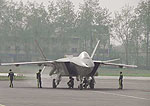Chinese military growth presents more risks
 The reach and capability of China’s navy and air force are expanding, posing a growing risk to security in Asia, military officials say.
The reach and capability of China’s navy and air force are expanding, posing a growing risk to security in Asia, military officials say.
A new aircraft carrier that began sea trials this summer and the public test flight in January of an advanced fighter jet designed to rival U.S. technology are just two examples of China’s growing military might, U.S. officials say.
China’s new focus on air, naval and missile capabilities reflects its desire for greater mobility to conduct operations at a greater distance from its mainland.
That’s according to a new 84-page Pentagon report outlining some of the latest intelligence on the Chinese military.
U.S. officials say that the pace and scope of China’s sustained military investment have allowed Beijing “to pursue capabilities that we believe are potentially destabilizing to regional military balances, increase the risk of misunderstanding … and may contribute to regional tensions and anxieties,” Michael Schiffer, deputy assistant secretary of defense for East Asia, told reporters Aug. 24 when the report was released.
The report estimates China’s total annual military spending at $160 billion, far less than the current Pentagon base budget of more than $500 billion.
A FORWARD-LOOKING NAVY
The Chinese have an arsenal of anti-ship missiles that include some modern Russian-made SS-N-22s and SS-N-27Bs.
The range of those missiles reaches out about 1,150 miles. In coordination with bomber aircraft, the Chinese reach extends beyond Japan and the South China Sea, potentially as far as Guam, the report says.
China now has Russian-made anti-radiation missiles, which home in on radio emissions and could be used to target naval radar systems in the Pacific. The Chinese are working on their own anti-radiation missiles and moving them into their fighter-bomber force, the report says.
Recent Chinese military plans from 2008 and 2010 show a focus shifting beyond Taiwan and developing weaponry with even more extended reach, including into the Indian Ocean.
Internal Chinese reports refer to “notable improvements” in the navy’s ability to equip and support long-distance operations. In the past two years, the Chinese navy conducted nine deployments to the Gulf of Aden near Africa for counter-piracy missions.
The Chinese have renovated a former Soviet aircraft carrier that began conducting sea trials this summer. U.S. officials expect them to build their own carrier in the near future, and probably more than one.
However, the Chinese navy has not conducted any carrier-based flight operations and the U.S. believes “it will still take several additional years for China to achieve a minimal level of combat capability on an aircraft carrier,” the report says.
The Chinese navy is far smaller than the U.S. Navy, with one aircraft carrier and 26 destroyers, compared to 11 carriers and 60 destroyers in the U.S. fleet.
STEALTH IN THE AIR
The Chinese air force shows a new ability to operate beyond the western Pacific. Last year, the Chinese deployed Su-27 fighters to Turkey for joint exercises and in February sent four long-haul transport aircraft to evacuate Chinese citizens from Libya, the first mission of its kind.
Last September, China used its B-6 Badger fleet to bomb targets in Kazakhstan as part of an international exercise. China is working to extend the range of the B-6, a long-range bomber that could deliver land-attack cruise missiles far beyond the western Pacific, the report said.
China also is developing a stealth fighter jet known as the J-20 that could rival some of the U.S. military’s top aircraft and give China the capability to mount “long-range, penetrating strikes into complex air-defense environments,” the report said.
The Pentagon does not believe the J-20 will be operational until 2018.
The Chinese air force remains far smaller than the U.S. fleet of aircraft. The Chinese have about 1,680 fighter jets compared to more than 3,000 in the U.S. Air Force and Navy together.
China’s most secretive military activity occurs in its network of underground facilities, which U.S. officials say are connected with more than 3,000 miles of tunnels. These facilities probably house command-and-control nodes, key communications sites, and development and storage areas for China’s most important weaponry.